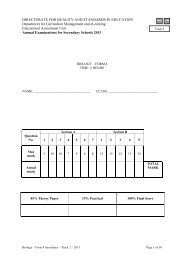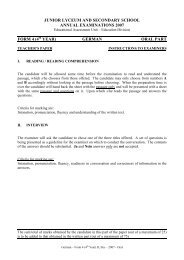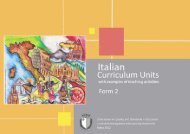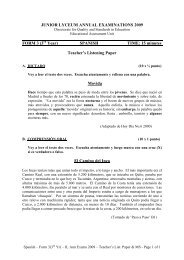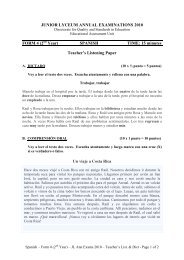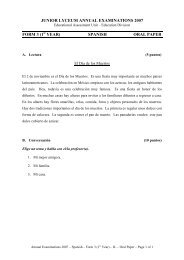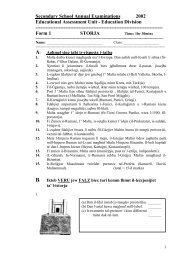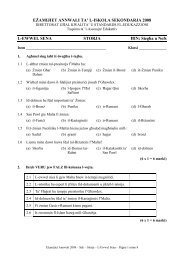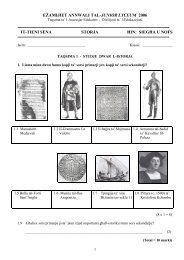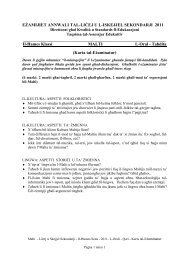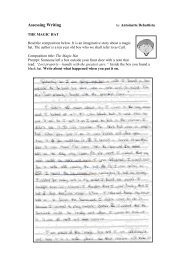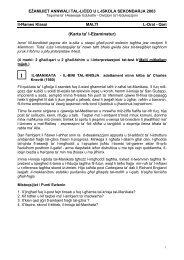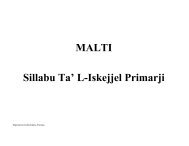Ich wohne in Tübingen. Tübingen ist eine alte schöne Stadt in der ...
Ich wohne in Tübingen. Tübingen ist eine alte schöne Stadt in der ...
Ich wohne in Tübingen. Tübingen ist eine alte schöne Stadt in der ...
Create successful ePaper yourself
Turn your PDF publications into a flip-book with our unique Google optimized e-Paper software.
JUNIOR LYCEUM ANNUAL EXAMINATIONS 2003<br />
Educational Assessment Unit – Education Division<br />
FORM 3 (year 1) GERMAN Oral Paper<br />
TEACHER´S PAPER INSTRUCTIONS TO EXAMINERS<br />
1. READING / READING COMPREHENSION<br />
The candidate will be allowed some time before the exam<strong>in</strong>ation to read and un<strong>der</strong>stand<br />
the passage which s/he chooses from those offered. The candidate may only choose<br />
between the letters A and B without look<strong>in</strong>g at the passages before choos<strong>in</strong>g. When the<br />
preparation time is over, the candidate will hand back the sheet with the passage only and<br />
will be presented with a sheet with the same passage and questions on it. Upon which<br />
s/he reads the passage and answers the questions.<br />
Criteria for mark<strong>in</strong>g are:<br />
Intonation; pronunciation; fluency and un<strong>der</strong>stand<strong>in</strong>g of text.<br />
II. INTERVIEW<br />
The exam<strong>in</strong>er will ask the candidate to choose one of the two letters A or B. When the<br />
choice is made, the exam<strong>in</strong>er will present the candidate with the correspond<strong>in</strong>g picture.<br />
The exam<strong>in</strong>er will put the question to the candidate twice ( or three times if necessary)<br />
and ascerta<strong>in</strong> that the candidate has un<strong>der</strong>stood it.<br />
The answer <strong>in</strong> German need not be a complete sentence.<br />
Criteria for mark<strong>in</strong>g are:<br />
Intonation; pronunciation; fluency; read<strong>in</strong>ess <strong>in</strong> conversation and correctness of<br />
<strong>in</strong>tonation <strong>in</strong> the answer.<br />
The sum total of marks obta<strong>in</strong>ed by the candidate <strong>in</strong> this part of the paper ( out of a<br />
maximum of 25) is to be added to that obta<strong>in</strong>ed <strong>in</strong> the written part ( out of a maximum of<br />
75).<br />
1
JUNIOR LYCEUM<br />
FORM III (1 st year)<br />
2<br />
EXAMINER`S SHEET<br />
I. READING / READING COMPREHENSION ( 6 & 5 marks)<br />
Alternative A<br />
<strong>Ich</strong> <strong>wohne</strong> <strong>in</strong> Tüb<strong>in</strong>gen. Tüb<strong>in</strong>gen <strong>ist</strong> e<strong>in</strong>e <strong>alte</strong> <strong>schöne</strong> <strong>Stadt</strong> <strong>in</strong> <strong>der</strong> Nähe von<br />
Stuttgart. Hier gibt es viel zu sehen. Viele Tour<strong>ist</strong>en kommen. Sie besuchen das<br />
Schloss und die Museen. Tüb<strong>in</strong>gen hat zwei Theater und drei K<strong>in</strong>os.<br />
1. Was <strong>ist</strong> Tüb<strong>in</strong>gen?<br />
2. Wo liegt Tüb<strong>in</strong>gen?<br />
3. Wer kommt nach Tüb<strong>in</strong>gen?<br />
4. Was besuchen sie?<br />
5. Wie viele Theater gibt es <strong>in</strong> Tüb<strong>in</strong>gen?<br />
Alternative B<br />
Me<strong>in</strong> Freund Chr<strong>ist</strong>oph <strong>ist</strong> 14 Jahre alt. Er <strong>ist</strong> ziemlich dick und hat kurze blonde<br />
Haare und braune Augen. Chr<strong>ist</strong>oph hat e<strong>in</strong> weißes T-Shirt und e<strong>in</strong>e dunkelblaue<br />
Hose an. Se<strong>in</strong>e Tra<strong>in</strong><strong>in</strong>gsschuhe s<strong>in</strong>d weiß und blau. <strong>Ich</strong> f<strong>in</strong>de ihn nett und<br />
sympathisch.<br />
1. Wie alt <strong>ist</strong> Chr<strong>ist</strong>oph?<br />
2. Wie sieht er aus?<br />
3. Was hat er an?<br />
4. Wie s<strong>in</strong>d Chr<strong>ist</strong>ophs Tra<strong>in</strong><strong>in</strong>gsschuhe?<br />
5. Wie f<strong>in</strong>dest du ihn?
JUNIOR LYCEUM<br />
FORM III (1 st year)<br />
I. READING / READING COMPREHENSION<br />
Alternative A<br />
3<br />
PUPIL`S SHEET<br />
<strong>Ich</strong> <strong>wohne</strong> <strong>in</strong> Tüb<strong>in</strong>gen. Tüb<strong>in</strong>gen <strong>ist</strong> e<strong>in</strong>e <strong>alte</strong> <strong>schöne</strong> <strong>Stadt</strong><br />
<strong>in</strong> <strong>der</strong> Nähe von Stuttgart. Hier gibt es viel zu sehen. Viele<br />
Tour<strong>ist</strong>en kommen. Sie besuchen das Schloss und die<br />
Museen. Tüb<strong>in</strong>gen hat zwei Theater und drei K<strong>in</strong>os.<br />
TO BE PREPARED BY THE CANDIDATE FIVE MINUTES BEFORE<br />
ENTERING THE EXAMINATION ROOM
JUNIOR LYCEUM<br />
FORM III (1 st year)<br />
4<br />
PUPIL`S SHEET<br />
I. READING / READING COMPREHENSION (6 & 5 marks)<br />
Alternative A<br />
<strong>Ich</strong> <strong>wohne</strong> <strong>in</strong> Tüb<strong>in</strong>gen. Tüb<strong>in</strong>gen <strong>ist</strong> e<strong>in</strong>e <strong>alte</strong> <strong>schöne</strong> <strong>Stadt</strong> <strong>in</strong> <strong>der</strong> Nähe<br />
von Stuttgart. Hier gibt es viel zu sehen. Viele Tour<strong>ist</strong>en kommen. Sie<br />
besuchen das Schloss und die Museen. Tüb<strong>in</strong>gen hat zwei Theater und<br />
drei K<strong>in</strong>os.<br />
1. Was <strong>ist</strong> Tüb<strong>in</strong>gen?<br />
2. Wo liegt Tüb<strong>in</strong>gen?<br />
3. Wer kommt nach Tüb<strong>in</strong>gen?<br />
4. Was besuchen sie?<br />
5. Wie viele Theater gibt es <strong>in</strong> Tüb<strong>in</strong>gen?<br />
TO BE READ AND ANSWERED IN THE EXAMINATION ROOM
JUNIOR LYCEUM<br />
FORM III (1 st year)<br />
I. READING / READING COMPREHENSION<br />
Alternative B<br />
5<br />
PUPIL`S SHEET<br />
Me<strong>in</strong> Freund Chr<strong>ist</strong>oph <strong>ist</strong> 14 Jahre alt. Er <strong>ist</strong> ziemlich<br />
dick und hat kurze blonde Haare und braune Augen.<br />
Chr<strong>ist</strong>oph hat e<strong>in</strong> weißes T-Shirt und e<strong>in</strong>e dunkelblaue<br />
Hose an. Se<strong>in</strong>e Tra<strong>in</strong><strong>in</strong>gsschuhe s<strong>in</strong>d weiß und blau. <strong>Ich</strong><br />
f<strong>in</strong>de ihn nett und sympathisch.<br />
TO BE PREPARED BY THE CANDIDATE FIVE MINUTES BEFORE<br />
ENTERING THE EXAMINATION ROOM
JUNIOR LYCEUM<br />
FORM III (1 st year)<br />
6<br />
PUPIL`S SHEET<br />
I. READING / READING COMPREHENSION (6 & 5 marks)<br />
Alternative B<br />
Me<strong>in</strong> Freund Chr<strong>ist</strong>oph <strong>ist</strong> 14 Jahre alt. Er <strong>ist</strong> ziemlich dick und hat<br />
kurze blonde Haare und braune Augen. Chr<strong>ist</strong>oph hat e<strong>in</strong> weißes T-Shirt<br />
und e<strong>in</strong>e dunkelblaue Hose an. Se<strong>in</strong>e Tra<strong>in</strong><strong>in</strong>gsschuhe s<strong>in</strong>d weiß und<br />
blau. <strong>Ich</strong> f<strong>in</strong>de ihn nett und sympathisch.<br />
1. Wie alt <strong>ist</strong> Chr<strong>ist</strong>oph?<br />
2. Wie sieht er aus?<br />
3. Was hat er an?<br />
4. Wie s<strong>in</strong>d Chr<strong>ist</strong>ophs Tra<strong>in</strong><strong>in</strong>gsschuhe?<br />
5. Wie f<strong>in</strong>dest du ihn?<br />
TO BE READ AND ANSWERED IN THE EXAMINATION ROOM
FORM III (1st Year)<br />
II . INTERVIEW A (14 marks)<br />
Picture No. 1<br />
1. Wie spät <strong>ist</strong> es?<br />
2. Wie viele Personen s<strong>in</strong>d auf dem Bild?<br />
3. Wo <strong>ist</strong> die Familie?<br />
4. Was tr<strong>in</strong>kt <strong>der</strong> Vater?<br />
5. Was macht er?<br />
6. Was macht die Mutter?<br />
7. Was machen die K<strong>in</strong><strong>der</strong>?<br />
TO BE HANDED TO THE CANDIDATE IN THE EXAMINATION ROOM<br />
AFTER THE READING COMPREHENSION IS FINISHED<br />
7
8<br />
EXAMINER`S SHEET<br />
FORM III (1st Year)<br />
II . INTERVIEW A (14 marks)<br />
Picture No. 1<br />
1. Wie spät <strong>ist</strong> es?<br />
2. Wie viele Personen s<strong>in</strong>d auf dem Bild?<br />
3. Wo <strong>ist</strong> die Familie?<br />
4. Was tr<strong>in</strong>kt <strong>der</strong> Vater?<br />
5. Was macht er?<br />
6. Was macht die Mutter?<br />
7. Was machen die K<strong>in</strong><strong>der</strong>?
JUNIOR LYCEUM<br />
FORM III (1st Year)<br />
II . INTERVIEW B (14 marks)<br />
Picture No 2.<br />
1. Wie spät <strong>ist</strong> es?<br />
2. Wo <strong>ist</strong> die Familie?<br />
3. Was machen die Eltern?<br />
4. Was macht die Mutter?<br />
5. Was <strong>ist</strong> auf dem Tisch?<br />
6. Was macht <strong>der</strong> Sohn?<br />
7. Was hat <strong>der</strong> Sohn <strong>in</strong> <strong>der</strong> Hand?<br />
TO BE HANDED TO THE CANDIDATE IN THE<br />
EXAMINATION ROOM AFTER THE READING COMPREHENSION<br />
IS FINISHED<br />
9
FORM III (1st Year)<br />
10<br />
EXAMINER`S SHEET<br />
II. INTERVIEW B (14 marks)<br />
Picture No. 2<br />
1. Wie spät <strong>ist</strong> es?<br />
2. Wo <strong>ist</strong> die Familie?<br />
3. Was machen die Eltern?<br />
4. Was macht die Mutter?<br />
5. Was <strong>ist</strong> auf dem Tisch?<br />
6. Was macht <strong>der</strong> Sohn?<br />
7. Was hat <strong>der</strong> Sohn <strong>in</strong> <strong>der</strong> Hand?
JUNIOR LYCEUM ANNUAL EXAMINATIONS 2003<br />
Educational Assessment Unit – Education Division<br />
FORM 3 (year 1) GERMAN Teacher’s Paper<br />
INSTRUCTIONS TO EXAMINERS WRITTEN PART<br />
HÖRVERSTÄNDNIS<br />
The Hörverständnis text should first be read out once as a whole. The teacher then<br />
allows the pupils time to read and un<strong>der</strong>stand the questions perta<strong>in</strong><strong>in</strong>g to Section I. She /<br />
He then reads out Section I once and allows five m<strong>in</strong>utes time for answer<strong>in</strong>g the<br />
questions. This process is repeated for the follow<strong>in</strong>g section. After which the passage is<br />
read out once aga<strong>in</strong> for check<strong>in</strong>g purposes.<br />
DIKTAT<br />
The Diktat text is first read out once at normal speech tempo. The teacher then reads<br />
out the text <strong>in</strong> groups of words, repeat<strong>in</strong>g each group and allow<strong>in</strong>g time for writ<strong>in</strong>g.<br />
After which the text is read out once aga<strong>in</strong> at the end at normal speech tempo for<br />
check<strong>in</strong>g purposes.<br />
________________________________________________________________________<br />
* The number of marks allotted <strong>in</strong> the Diktat should reflect the proportion of the number<br />
of correct words as aga<strong>in</strong>st that of the m<strong>ist</strong>aken ones.<br />
The sum total of marks obta<strong>in</strong>ed by the candidate <strong>in</strong> this part of the paper (out of a<br />
maximum of 75) is to be added to that obta<strong>in</strong>ed <strong>in</strong> the oral part(out of a maximum of 25<br />
marks)<br />
11
I. HÖRVERSTÄNDNISTEXT<br />
Section 1<br />
FORM III (1st Year)<br />
12<br />
EXAMINER`S SHEET<br />
Me<strong>in</strong>e Freund<strong>in</strong> Katya kommt aus Österreich. Sie wohnt <strong>in</strong> Wien. Katyas<br />
Familie hat e<strong>in</strong> Haus <strong>in</strong> <strong>der</strong> <strong>Stadt</strong>mitte. Das Haus <strong>ist</strong> groß und hat sieben<br />
Zimmer. Es hat e<strong>in</strong>en großen Balkon aber ke<strong>in</strong>en Garten.<br />
Section 2<br />
Katya hat nur e<strong>in</strong>e Schwester. Sie hat aber viele Haustiere. Katya hat e<strong>in</strong>en<br />
schwarzen Hund, e<strong>in</strong>en Hamster und viele Fische. Nach <strong>der</strong> Schule geht<br />
Katya mit dem Hund spazieren. Katyas Eltern arbeiten <strong>in</strong> <strong>der</strong> Konditorei.<br />
Sie verkaufen Kuchen und Kekse.<br />
II. DIKTATTEXT<br />
Das Wetter <strong>ist</strong> fantastisch. / Die Sonne sche<strong>in</strong>t. / Morgens gehen wir<br />
spazieren /und abends gehen wir / <strong>in</strong> die Disco. Wir hören mo<strong>der</strong>ne<br />
Musik / und tanzen. / Toll, nicht ?
Form 3 / 1st Year TEACHER’S Mark<strong>in</strong>g Scheme<br />
I. HÖRVERSTÄNDNIS<br />
Section 1 1 mark each correct answer<br />
1. aus Österreich.<br />
2. <strong>in</strong> Wien.<br />
3. groß.<br />
4. <strong>in</strong> <strong>der</strong> <strong>Stadt</strong>mitte.<br />
5. sieben.<br />
Section 2 1 mark each correct answer<br />
6. e<strong>in</strong>e Schwester.<br />
7. e<strong>in</strong>en Hund, e<strong>in</strong>en Hamster und viele Fische.<br />
8. sie geht mit dem Hund spazieren.<br />
9. <strong>in</strong> <strong>der</strong> Konditorei.<br />
10. Kuchen (½ mark) und Kekse (½ mark)<br />
II. DIKTAT<br />
Refer to Dictation text <strong>in</strong> Teacher’s paper.<br />
The number of marks allotted <strong>in</strong> the Diktat should reflect the proportion of the<br />
number of correct words as aga<strong>in</strong>st that of the m<strong>ist</strong>aken ones.<br />
III. LESEVERSTÄNDNIS 2 marks each<br />
1. Roberta schreibt den Brief .<br />
2. Sie hat am 15. Juni Geburtstag.<br />
3. Am Nachmittag gibt sie e<strong>in</strong>e Party.<br />
4. Nach <strong>der</strong> Party fahren die Freunde <strong>in</strong> die <strong>Stadt</strong>.<br />
5. Sie fahren mit <strong>der</strong> U-Bahn dorth<strong>in</strong>/ <strong>in</strong> die <strong>Stadt</strong>.<br />
6. Sie gehen <strong>in</strong>s K<strong>in</strong>o o<strong>der</strong> zu e<strong>in</strong>em Konzert.<br />
13
IV. GRAMMATIK<br />
Un<strong>der</strong>l<strong>in</strong>e the correct word or phrase 1 mark each<br />
1. roten 2. um 3. e<strong>in</strong><br />
4. <strong>der</strong> 5. schwarze 6. woh<strong>in</strong><br />
7. mit 8. dem 9. für<br />
10. ersten 11. isst 12. willst<br />
13. <strong>der</strong> 14. Glas 15. fährt mit dem Bus <strong>in</strong> die<br />
<strong>Stadt</strong>.<br />
V. CREATIVE WRITING 2 marks each<br />
Y: Mit dem Bus/ <strong>Ich</strong> fahre mit dem Bus zur Schule / <strong>Ich</strong> gehe zu Fuß.<br />
I: Wann beg<strong>in</strong>nt die Schule/<strong>der</strong> Unterricht?<br />
Y: Am Montag habe ich ______ Stunden.<br />
I: Was s<strong>in</strong>d de<strong>in</strong>e Liebl<strong>in</strong>gsfächer?<br />
I: Welches Fach gefällt dir nicht?<br />
Y: Zwischen _____ und ________./ nachmittags /abends. o.Ä.<br />
I: Was machst du abends?<br />
VI. CREATIVE WRITING<br />
8 marks : Contents and amount, choice of words, idioms, comprehension.<br />
8 marks : Formal correctness: syntax, morphology, orthography, punctuation.<br />
14
JUNIOR LYCEUM ANNUAL EXAMINATIONS 2003<br />
Educational Assessment Unit – Education Division<br />
FORM 3 (year 1) GERMAN TIME: 1h 30m<strong>in</strong><br />
MARKS:<br />
ORAL (max 25) WRITTEN (max 75) TOTAL<br />
NAME :____________________________________ CLASS:____________________<br />
I. HÖRVERSTÄNDNIS (10 marks)<br />
L<strong>ist</strong>en to the passage carefully and answer IN BRIEF the follow<strong>in</strong>g questions:<br />
Section 1<br />
1. Woher kommt Katya?<br />
2. Wo wohnt sie?<br />
3. Wie <strong>ist</strong> das Haus?<br />
4. Wo <strong>ist</strong> das Haus?<br />
5. Wie viele Zimmer hat das Haus?<br />
Section 2<br />
6. Wie viele Geschw<strong>ist</strong>er hat Katya?<br />
7. Was für Haustiere hat sie?<br />
8. Was macht Katya nach <strong>der</strong> Schule?<br />
9. Wo arbeiten Katyas Eltern?<br />
10. Was verkaufen sie?<br />
II. DIKTAT ( 8 marks)<br />
________________________________________________________________________<br />
________________________________________________________________________<br />
________________________________________________________________________<br />
________________________________________________________________________<br />
________________________________________________________________________<br />
________________________________________________________________________<br />
15
III. LESEVERSTÄNDNIS: (12 marks)<br />
Read the follow<strong>in</strong>g passage carefully and answer the questions IN FULL:<br />
Liebe Ingrid,<br />
16<br />
Bonn, den 5. Juni 2003<br />
vielen Dank für de<strong>in</strong>en Brief. Wie geht’s? Mir geht’s gut! Am 15. Juni habe ich<br />
Geburtstag. Es <strong>ist</strong> Sonntag und wir haben ke<strong>in</strong>e Schule. Toll! Am Nachmittag gebe ich<br />
e<strong>in</strong>e Party. Me<strong>in</strong>e Freunde kommen; wir essen, tr<strong>in</strong>ken, hören Musik und tanzen. Nach<br />
<strong>der</strong> Party fahre ich mit me<strong>in</strong>en Freunden mit <strong>der</strong> U-Bahn <strong>in</strong> die <strong>Stadt</strong>. Wir gehen <strong>in</strong>s<br />
K<strong>in</strong>o und sehen e<strong>in</strong>en tollen Film o<strong>der</strong> wir gehen zu e<strong>in</strong>em Konzert im <strong>Stadt</strong>park.<br />
Wann hast du Geburtstag? Was machst du an de<strong>in</strong>em Geburtstag? Schreib mir bald!<br />
Tschüss<br />
Roberta<br />
1. Wer schreibt den Brief?<br />
2. Wann hat Roberta Geburtstag?<br />
3. Was macht sie am Nachmittag?<br />
4. Woh<strong>in</strong> fahren die Freunde nach <strong>der</strong> Party?<br />
5. Wie fahren sie dorth<strong>in</strong>?<br />
6. Was machen sie dort ?<br />
IV. GRAMMATIK (15 marks)<br />
Un<strong>der</strong>l<strong>in</strong>e the correct word or phrase:<br />
1. Sie hat e<strong>in</strong>en (roter, rotes, roten) Pullover an.<br />
2. Die Schule beg<strong>in</strong>nt (am, um, im) halb neun.<br />
3. Mart<strong>in</strong>a hat (e<strong>in</strong>, e<strong>in</strong>e, e<strong>in</strong>en) Pferd.<br />
4. Entschuldigung! Wo <strong>ist</strong> hier (<strong>der</strong>, den, das) Bahnhof?<br />
5. Er kauft (schwarze, schwarzen, schwarz) Schuhe.<br />
6. (Wo, Woher, Woh<strong>in</strong>) fährst du? - Nach Italien.
7. Wir fahren (mit, von, bei) dem Bus zur Schule.<br />
8. Der Dom <strong>ist</strong> vor (dem, das, den) Rathaus.<br />
9. Me<strong>in</strong> Bru<strong>der</strong> gibt se<strong>in</strong> Geld (vor, für, von) CDs aus.<br />
10. In <strong>der</strong> (erster, ersten, erste) Stunde habe ich Deutsch.<br />
11. Am liebsten (isst, esse, <strong>ist</strong>) Karl Obst.<br />
12. (Wollst, Willst, Will) du e<strong>in</strong>en Film sehen?<br />
13. Peter und Paul s<strong>in</strong>d <strong>in</strong> (<strong>der</strong>, die, dem) Konditorei.<br />
14. Er kauft e<strong>in</strong> (Becher, Glas, Dose) Honig.<br />
15. De<strong>in</strong>e Schwester (fährt <strong>in</strong> die <strong>Stadt</strong> mit dem Bus)<br />
(<strong>in</strong> die <strong>Stadt</strong> fährt mit dem Bus)<br />
(fährt mit dem Bus <strong>in</strong> die <strong>Stadt</strong>).<br />
V. CREATIVE WRITING (14 marks)<br />
You are <strong>in</strong>terviewed for the school magaz<strong>in</strong>e. Fill <strong>in</strong> the miss<strong>in</strong>g sentences<br />
<strong>in</strong> the follow<strong>in</strong>g dialogue.<br />
I : Tag! Wie fährst du zur Schule?<br />
Y = You I = Interviewer<br />
Y : ___________________________________________________________________<br />
I : __________________________________________________________________?<br />
Y : Um halb neun.<br />
I : Wie viele Stunden hast du am Montag?<br />
Y : ___________________________________________________________________<br />
I : __________________________________________________________________?<br />
Y : Mathe und Sport. <strong>Ich</strong> f<strong>in</strong>de sie super.<br />
I : __________________________________________________________________?<br />
Y : Kunst. <strong>Ich</strong> f<strong>in</strong>de Kunst st<strong>in</strong>klangweilig.<br />
I : Wann machst du de<strong>in</strong>e Hausaufgaben?<br />
Y: ___________________________________________________________________<br />
I: __________________________________________________________________?<br />
Y: Abends treffe ich mich mit Freunden und sehe fern.<br />
17
VI . COMPOSITION (16 marks)<br />
Write your COMPOSITION on a separate sheet of paper.<br />
In 80 words write about ONE of the follow<strong>in</strong>g:<br />
Either: Write a letter to your penfriend <strong>in</strong> which you tell him/her how you spend<br />
your day.<br />
a) Tell him/her what you do <strong>in</strong> the morn<strong>in</strong>g.<br />
b) Say what you do at school.<br />
c) Mention what activities you do after school.<br />
d) Tell/her also how you spend the even<strong>in</strong>g.<br />
Or: Describe the story <strong>in</strong> these pictures.<br />
18



